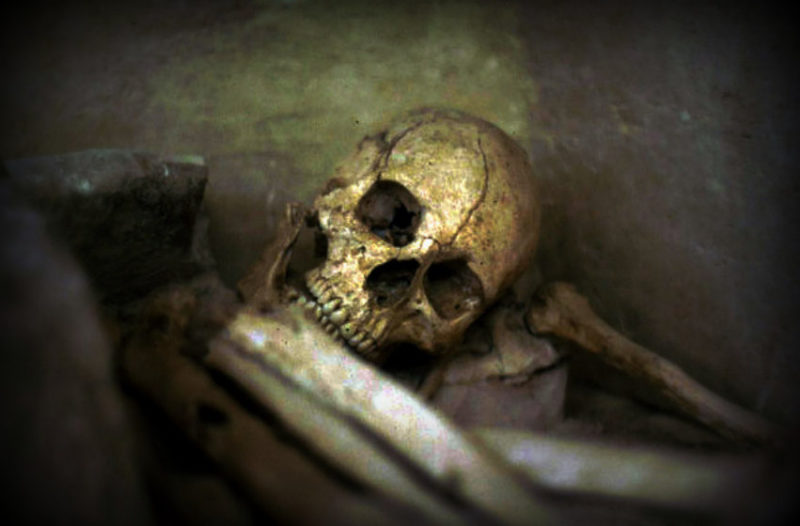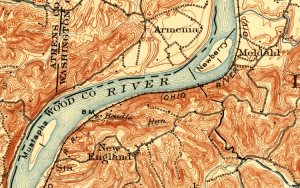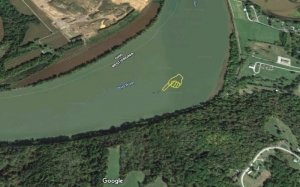PARKERSBURG, W.Va. — Could the body of an unfortunate ship's clerk lie buried in a murky vault beneath the Ohio River? If the full tale of the horrific Wreck of the Kanawha in the early 1900s is true, there's a chance it could.
However, tracking down the details of that terrible night is problematic. The dam at which the steamer wrecked, and the island above which it reputedly overturned, are long gone. Even the date on which the wreck occurred is variously reported.
According to one source, the tragedy occurred early on January 15, 1915, as the ship passed south beyond Parkersburg, West Virginia. Sixty-five people might have been aboard at the time.
The tale is only one of many that recount the tragedies that befell steamboats in that area, and the river at Parkersburg was once known as a ship's graveyard. Many watercraft met their end there where the river turned sharply west.
The most detailed account was provided in the W.Va. Heritage Encyclopedia, published in 1976 and cited here.
The Wreck of the Kanawha
Around 1912, the steamer Kanawha, a fast packet, was operating on the upper Ohio River with a run from Pittsburgh to Cincinnati. On the second trip, after it had been overhauled, the passage from Pittsburgh to Parkersburg was made with only two minor incidents.
On the way, a family of German origin came aboard as passengers, and during the trip, the engineer, Dude Pettit, discovered that a hog rod on the boat was broken. Hog-rods are metal cantilever braces designed to stiffen and strengthen the hulls of boats.
Pettit realized that the use of full power, with the brace broken, might cause the hull to buckle, and, accordingly, he advised the captain, Brady Berry, that the full power of the engines could not be used.
When the Kanawha arrived at Parkersburg during the night, a storm raged, and a very high wind was whipping the river into muddy foam. The wharf master, alarmed by the tempest, requested Captain Berry not to continue until the storm had abated.
The captain, however, considered the time he had lost on the way due to the broken hog rod and decided to go on. So the Kanawha steamed slowly away from the Parkersburg wharf and fought her way down the river through the gale.
In the early morning, the Kanawha stopped at Dam No. 19. At about 3 a.m., Captain Berry ordered the lines cast off, and the steamer backed away from the sheltering walls to resume her journey.
Read also: Could a pirate treasure on the Ohio River be lost for good?; 1869 wreck of steamer Rebecca occurred Dec. 7 on the Ohio
As the Kanawha neared the middle of the river, the terrible force of the wind caught her and swept her inexorably toward the walls of the dam. If the full power of the engines could have been used, she might have been saved, but because of the broken hog rod, this could not be done.
When she struck, a hole six feet wide and twenty feet long was ripped in the hull. Swept on down the river by the current, she was swamped in three minutes.
In the boat's safe, a large vault-like affair, was more than two thousand dollars. Clark de Wolfe, the boat's clerk, realizing the disaster when the boat struck the dam, had hurried to the safe to save the money in his charge.
At Newberry Island, the boat turned over, and the boilers and heavy machinery crashed through the sides. Neither the clerk nor the safe was ever seen again, and it is believed that the safe, with the unfortunate clerk inside, lies with the boilers at the bottom of the river.
Every member of the German family was drowned. An eighty-year-old woman climbed on the swamped hull and was rescued. Dude Pettit, the engineer, supported himself on a chicken coop and a door and floated eighteen miles to Long Bottom.
The Kanawha grounded at the foot of Mustapha Island. John McConnell, the nephew of Ira McConnell, owner of the dry docks on the Little Kanawha River, owned a motorboat named the Teaser, in which three bodies found aboard the Kanawha were brought to Parkersburg.
Graveyard of the Ohio now a favorite tourist destination

The Ohio River below Parkersburg, West Virginia, was long ago known as the Graveyard of the Ohio and was considered one of the most dangerous sections on the 981-mile waterway. Now a popular destination for water recreation, it was long littered with the wrecks of steamers and barges, and mariners and passengers untold met their ends in its watery depths. Read the full story here.
Sign up to receive a FREE copy of West Virginia Explorer Magazine in your email twice weekly. Sign me up!




